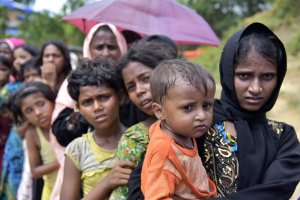Thousands of members of the Christian Chin community—who escaped everything from severe religious persecution, forced labor and sexual violence to torture and extrajudicial killings in their native Burma (Myanmar)—are now finding themselves as refugees in the United States contending with an entirely different kind of menace: COVID-19.

At a time when the pandemic continues to disproportionately ravage minority communities, health authorities and advocates are worried that the virus might be affecting Chins.
Indianapolis is home to an estimated 15,000 to 20,000 Burmese refugees. The landscape is dotted with Chin Christian churches and Burmese restaurants and grocery stores. Providing Chins reliable information about COVID-19 has proven challenging, according to WFYI, an Indianapolis-based National Public Radio affiliate.
When Indiana Governor Eric Holcomb issued a stay-at-home order for the state, for example, his office posted a “Frequently Asked Questions” (FAQ) page online, available only in English.
Indiana residents “who cannot read English have difficulty accessing reliable information about the developing emergency,” according to the Office of the Vice President for Diversity, Equity, and Multicultural Affairs at Indiana University. “One group who may be particularly affected by this lack of information is the more than 25,000 Burmese refugees who call Indiana home—19,000 of whom live in Indianapolis.”
The report noted that Chin refugees are most likely to speak an obscure subgroup of “Kuki-Chin” tongues from the Tibeto-Burman language family. “Our best guess is that there are between 30 and 50 Kuki-Chin languages spoken in Indianapolis,” according to Indiana University Assistant Professor of Linguistics Kelly Berkson. “All of these languages are under-resourced. Many of them are completely undocumented, meaning that there is no work done on them whatsoever. Yet there are hundreds or thousands of speakers right here in Indiana, and materials related to critical topics like the COVID-19 pandemic are needed.”
The Chin Languages Research Project (CLRP) at the university’s Department of Linguistics wasted little time in rising to the challenge after a student who is part of the Chin community alerted researchers there that many community members are unlettered in English. The team “changed its focus from data research on other languages to translating information regarding the coronavirus” released by official sources such as the World Health Organization and the Indiana State Department of Health, according to an article in the Indiana Daily Student. Pandemic-related information was translated into the Laiholh language, which is also known as Hakha Lai and is spoken by as many as 10,000 Indiana residents, according to CLRP researchers. The information was then posted online, along with FAQs about financial stimulus checks and the state government’s sheltering-in-place order.
The Chin are ethnically and linguistically diverse and are concentrated largely in the remote, mountainous Chin State in western Burma near the border of India. With a population of about 500,000, they are among Burma’s poorest and most persecuted minorities, vastly underserved by just 12 hospitals, 56 doctors and 128 nurses. They have access to only 25 high schools and no universities as of 2009, according to a Human Rights Watch report.
In addition to a disproportionately high poverty rate, the Chin face “human rights violations on a large scale,” notes a 2018 report by the Unrepresented Nations and Peoples Organization (UNPO). “As the majority of the Chin is Christian, while the de facto religion in Myanmar is Buddhism, the Chin are discriminated against and marginalized. Buddhism has a special status in the country, while minority religions are just recognized as ‘existing’ but not explicitly protected.”
The Indiana University team has been committed to providing essential information to this marginalized community.
“This is new territory for all of us,” according to Professor Berkson, “The graduate students have never built a website. I have no experience with fund-raising, but I need to be able to support my students. The undergrads are translating materials into a language with no academic study on translation behind them. We’ve all faced a steep learning curve, but the project is so, so important. The pandemic is a scary time for everyone, especially for those in vulnerable communities. My students just want to help by providing their community members with critical information, both to prevent fear and so people know how to protect themselves.”
From its beginnings, the Church of Scientology has recognized that freedom of religion is a fundamental human right. In a world where conflicts are often traceable to intolerance of others’ religious beliefs and practices, the Church has, for more than 50 years, made the preservation of religious liberty an overriding concern.
The Church publishes this blog to help create a better understanding of the freedom of religion and belief and provide news on religious freedom and issues affecting this freedom around the world.
For more information, visit the Scientology website or Scientology Network.


